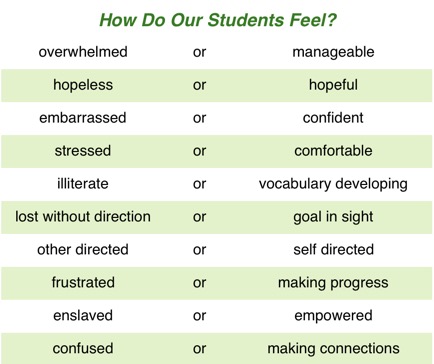While consulting with a group of college professors, the discussion turned (once again) to the notion of curriculum rigor. In recent years, rigor has become a driving buzzword – used particular by administrators, the the K12 assessment folks and sometimes parents.
Ironically, when one considers the definition, it is really not a pleasant term.
1 : harsh inflexibility in opinion, temper, or judgment : severity (2) : the quality of being unyielding or inflexible : strictness
2 : an act or instance of strictness, severity, or cruelty 3 : a tremor caused by a chill
4 : a condition that makes life difficult, challenging, or uncomfortable; especially : extremity of cold
5 : strict precision : exactness
6 : rigidity, stiffness b : rigidness or torpor of organs or tissue that prevents response to stimuli i.e. rigor mortis (Merriam-Webster)
2 : an act or instance of strictness, severity, or cruelty
3 : a tremor caused by a chill
4 : a condition that makes life difficult, challenging, or uncomfortable; especially : extremity of cold
5 : strict precision : exactness
6 : rigidity, stiffness b : rigidness or torpor of organs or tissue that prevents response to stimuli i.e. rigor mortis
(Merriam-Webster)
Who wants any of these definitions characterizing their course, their classroom, their studies?!
After reviewing the literal definitions of the term: rigor, it becomes more evident what people
feel while learning is very important.
A former principal was fond of saying, "If you don't have their hearts, you have no business with their minds!"
How do your students view your class? As an educator, I hate it when I hear my students say, "I am not good at science (or whatever the subject is)".
I realize what is meant by most of those that urge us to have more rigor is simply that they want our students to be challenged, to learn more, to increase their skills. I get the 'no pain, no gain notion'. I believe that we occasionally need to 'move the cheese'. We are not babysitting, and the education enterprise is quite expensive – so society and our
customers (students and parents) have a right to set some expectations.
It seems to be all about balance and how we frame the the challenging new material or difficult skills - as I think about how I teach my students, I decided I would coin a new expression:
Soft Rigor The birth of this term is built on years of using daily peer assessments develop more effective / professional level communication skills in my video productions course. Early in the course we establish best practices for multimedia communications. Then we set ground rules for critiquing each other's work. Every conversation is expected to acknowledge creativity and successful efforts while addressing shortcomings constructively. We talk about the opportunities for learning that failure presents and that without failure, learning is impossible. I
soften my course
rigor by watching for discouragement, looking for that moment when I can hear their heart saying, "it is never 'good enough.'" And I swoop in at that moment to show them an early product – I identify and applaud the progress towards perfection that they have made. I acknowledge factors out of their control that prevented them from going all the way. But most importantly, I have to reframe the student's view of failure in my course. Failure is necessary to learning.
“Failures are finger posts on the road to achievement.” - C.S. Lewis
Soft Rigor is an approach to challenging content, difficult skills, or precision/detailed work that allows time for failure, approximation, review, reframing, processing, iterations and reasonable progress. It is when we learn together, we provide choice, we learn to critique positively and constructively, and we embrace failure gracefully. Educators soften rigor by establishing context and relevance early – what is the purpose in obtaining this skill or building this understanding, what is the value to the students
now?
We soften rigor by recognizing that
learning does not occur in a steady, linear, rising fashion, but often occurs in spontaneous spikes that follow repeated failures. Coverage of rigorous topics doesn't result comprehension. Maybe most importantly, Soft Rigor is not inflexible, restrictive – it elevates choice, perspective, experience, creativity and passion.
Rigor still is a brutally unpleasant word, but if educators will carefully frame their
rigorous expectations with the opportunity to fail gracefully and and progressively improve – insuring their students don't become overly stressed, confused, frustrated, or disengaged, our learning culture will bring success.
As you reflect on your Learning Culture last year and plan your Learning Culture for the next year – what changes can you make to promote Soft Rigor?




